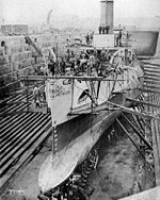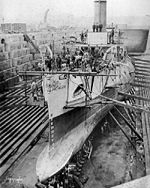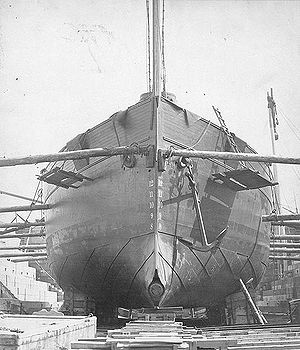
Torpedo ram
Encyclopedia

Torpedo boat
A torpedo boat is a relatively small and fast naval vessel designed to carry torpedoes into battle. The first designs rammed enemy ships with explosive spar torpedoes, and later designs launched self-propelled Whitehead torpedoes. They were created to counter battleships and other large, slow and...
combining a ram
Naval ram
A naval ram was a weapon carried by varied types of ships, dating back to antiquity. The weapon consisted of an underwater prolongation of the bow of the ship to form an armoured beak, usually between six and twelve feet in length...
with torpedo
Torpedo
The modern torpedo is a self-propelled missile weapon with an explosive warhead, launched above or below the water surface, propelled underwater towards a target, and designed to detonate either on contact with it or in proximity to it.The term torpedo was originally employed for...
tubes. Incorporating design elements from the cruiser
Cruiser
A cruiser is a type of warship. The term has been in use for several hundreds of years, and has had different meanings throughout this period...
and the monitor
Monitor (warship)
A monitor was a class of relatively small warship which was neither fast nor strongly armoured but carried disproportionately large guns. They were used by some navies from the 1860s until the end of World War II, and saw their final use by the United States Navy during the Vietnam War.The monitors...
, it was intended to provide small and inexpensive weapon systems for coastal defence and other littoral combat.
Like a monitor, torpedo rams operated with very little freeboard, sometimes with only inches of hull rising above the water, exposing only their funnels and turrets to enemy fire. In addition to the guns in their turrets, they also were equipped with torpedoes. Early designs incorporated a spar torpedo
Spar torpedo
A spar torpedo is a weapon consisting of a bomb placed at the end of a long pole, or spar, and attached to a boat. The weapon is used by running the end of the spar into the enemy ship. Spar torpedoes were often equipped with a barbed spear at the end, so it would stick to wooden hulls...
that could be extended from the bow and detonated by ramming a target. Later designs used tube-launched self-propelled torpedo
Torpedo
The modern torpedo is a self-propelled missile weapon with an explosive warhead, launched above or below the water surface, propelled underwater towards a target, and designed to detonate either on contact with it or in proximity to it.The term torpedo was originally employed for...
es, but retained the concept of ramming, resulting in designs like HMS Polyphemus
HMS Polyphemus (1881)
The third HMS Polyphemus was a Royal Navy torpedo ram, serving from 1881 until 1903. A shallow-draft, fast, low-profile vessel, she was designed to penetrate enemy harbours at speed and sink anchored ships. Designed by Nathaniel Barnaby primarily as a protected torpedo boat, the ram was provided...
, which had five torpedo tubes, two each port and starboard and one mounted in the center of her reinforced ram bow.
The torpedo ram concept came about at a time when the self-propelled torpedo, pioneered by Robert Whitehead
Robert Whitehead
Robert Whitehead was an English engineer. He developed the first effective self-propelled naval torpedo. His company, located in the Austrian naval centre in Fiume, was the world leader in torpedo development and production up to the First World War.- Early life:He was born the son of a...
, had only just been invented. The earliest self-propelled torpedoes were obviously very powerful weapons, but were very short-ranged and incapable of reaching speeds greater than 10 knots, making them useless against anything but stationary targets. Another result of this was that for a time there was much confusion in naval circles about how best to employ the torpedo. During the 1870s a large number of proposals emerged for torpedo-carrying warships.
The torpedo ram, like most of the early torpedo-carrying warship designs, was intended to attack enemy warships while they were still at anchor in harbor. The torpedo ram's low profile and high speed were to make discovery and interception harder, as was the commonly stated intent for their attacks to take place at night. Once it reached the harbor, the torpedo ram was to smash its way through any seaward harbor defenses and make straight for the ships lying at anchor, firing its torpedoes before they could get underway. Once this was done, the torpedo ram would exit the harbor and make a high-speed escape to waiting friendly forces.

USS Intrepid (1874)
The second USS Intrepid, was a steam-powered torpedo ram built in 1874 that had the distinction of being the first U.S. Navy ship armed with self-propelled torpedoes...
. Neither saw a great deal of active service and they were mostly used for torpedo trials, although Polyphemus did demonstrate the potential damage she could inflict when she was used to demolish a harbor jetty via ramming.
While never popular with the naval services that created them, the torpedo ram can be said to have caught public attention in a manner which far exceeded its utility as a concept for a fighting ship. The heroic HMS Thunder Child
HMS Thunder Child
HMS Thunder Child is the name of the fictional ironclad torpedo ram of the Royal Navy that is destroyed by Martian fighting-machines in H. G. Wells' The War of the Worlds...
in H. G. Wells
H. G. Wells
Herbert George Wells was an English author, now best known for his work in the science fiction genre. He was also a prolific writer in many other genres, including contemporary novels, history, politics and social commentary, even writing text books and rules for war games...
's science-fiction classic The War of the Worlds was a torpedo ram, and she destroyed two Martian Tripods
Tripod (The War of the Worlds)
Tripods or fighting-machines are a type of fictional three-legged walker from the H. G. Wells' classic science fiction novel The War of the Worlds, used by Martians to invade Earth.-Novel:...
. It has been suggested by some that, in view of the limited military value the torpedo ram demonstrated, Wells's immortalization of the type in what would become a literary classic was the torpedo ram's greatest achievement.

